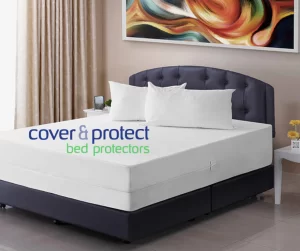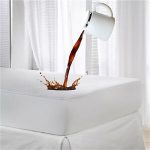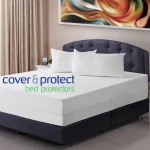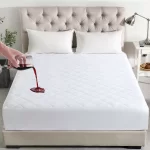
Choosing the Correct Mattress Protector for You and Your Family.
Please visit our website for all your mattress and bedding protection products
Introduction: The Importance of a Mattress Protector
Selecting the right mattress protector isn’t just about adding a layer to your mattress; it’s an investment in your family’s comfort, health, and well-being. A mattress protector is designed to shield your mattress from allergens, dust mites, moisture, spills, and even bed bugs. Whether you’re looking to extend the life of a high-end mattress or keep an older mattress fresh, a well-chosen mattress protector provides peace of mind, knowing that your family’s sleep environment is clean and protected.
In this guide, we’ll explore everything you need to know about choosing the correct mattress protector to suit your family’s unique needs. We’ll break down the different types, key features, and factors to consider for children, adults, and elderly family members, as well as tips for maintaining your protector.
1. Understanding Your Family’s Needs
Every family has different needs when it comes to choosing a mattress protector. Some may prioritize hypoallergenic properties, while others need waterproof protection. Here’s a closer look at the main factors to consider.
Allergies or Asthma: If someone in your household suffers from asthma or allergies, a hypoallergenic mattress protector can help create a safer sleeping environment. These protectors prevent allergens, such as dust mites, pollen, and pet dander, from accumulating on your mattress. Click link for Asthma and Allergy Information
Children and Pets: Families with young children or pets often deal with spills and accidents. In these cases, a waterproof mattress protector is essential, protecting the mattress from damage and making it easy to clean.
Climate and Temperature: Climate considerations are also key. Hot sleepers or those in warm regions might benefit from a cooling protector that regulates temperature, while those in colder areas may prefer a thicker option that provides warmth.
Ease of Cleaning: Some families prioritize easy-care options that are machine washable, reducing maintenance and allowing for frequent laundering to keep the mattress fresh and hygienic.
2. Types of Mattress Protectors Explained
With different types of protectors available, understanding their unique features can help you make an informed choice.
Waterproof Mattress Protectors

Waterproof protectors are ideal for families with young children, elderly members, or pets. Made with a protective layer of vinyl or polyurethane, these protectors prevent spills, sweat, and other liquids from soaking into the mattress. Some waterproof protectors feature noiseless materials, making them comfortable and discreet.
- Materials: Look for high-quality, breathable materials such as cotton terry with a polyurethane backing for waterproofing. This blend allows for comfort while effectively blocking liquids.
- Ideal Uses: Best for families with children prone to accidents, homes with pets, or anyone who wants to avoid mattress stains.
Hypoallergenic and Dust-Mite Resistant Protectors
These protectors are a must-have for allergy sufferers. Hypoallergenic protectors reduce allergens like dust mites, mold, and mildew that can trigger respiratory issues. Many hypoallergenic protectors are crafted from natural materials like organic cotton or bamboo, both known for their hypoallergenic qualities.
- Materials: Organic cotton, bamboo, or polyester blends. Look for protectors certified by organizations like OEKO-TEX, which tests for harmful substances. Click Link for materials information.
- Ideal Uses: For those with asthma or allergies, or anyone looking to minimize exposure to dust mites and allergens.
Cooling and Temperature-Regulating Protectors
If you live in a warm climate or struggle with overheating during the night, a cooling mattress protector may be the right choice. These protectors incorporate breathable materials, such as moisture-wicking fabrics or gel-infused fibers, to regulate temperature and provide a cooler sleep experience.
- Materials: Options include cotton, Tencel, and phase-change materials (PCM) that absorb body heat.
- Ideal Uses: Suitable for hot sleepers, those in warm climates, or anyone who finds traditional protectors too warm.
Bed Bug Proof Mattress Protectors

Bed bug-proof protectors are specifically designed to trap bed bugs inside the mattress while preventing new infestations. These protectors fully encase the mattress, often with a secure zipper, to block bed bugs and other pests.
Read article on: Master the Art of Bed Bug Prevention
- Materials: Typically constructed from durable, tightly woven fabrics like polyester.
- Ideal Uses: For households concerned about bed bugs or in regions where bed bug issues are common.
3. Key Features to Look for in a Quality Mattress Protector
Knowing which features are most important can help you find the best mattress protector for your needs.
Materials and Breathability
The material of the mattress protector can impact comfort and breathability. Natural fibers like cotton or bamboo are soft, breathable, and ideal for sensitive skin. Synthetic materials, such as polyester, can be more affordable and durable but may not offer the same level of breathability.
Comfort and Fit
A well-fitting mattress protector should stay snug on the mattress, without bunching or slipping. Protectors come in standard sizes, but mattress depths vary, so be sure to measure your mattress depth and select a protector that accommodates it.
Ease of Cleaning and Durability
Some mattress protectors are machine washable, making them easy to maintain. Look for protectors with easy-care instructions, as this will save time and effort in the long run.
Noise Level
If you’re a light sleeper, the noise level of your mattress protector matters. Look for protectors labeled as “noiseless” or those made from cotton or bamboo, which tend to be quieter than vinyl or plastic options.
Certified Health and Safety Standards
Certifications from organizations such as OEKO-TEX or GREENGUARD ensure that the protector is free from harmful chemicals, which can be especially important for families with young children or those with allergies.
4. Mattress Protector Options for Different Family Members
For Babies and Young Children
Young children often have night time accidents, so waterproof and easy-to-clean options are ideal. Look for machine-washable protectors with a soft, noiseless backing that won’t disrupt their sleep.
For Teens and Adults
Older children and adults may prefer mattress protectors that prioritize comfort, breathability, and temperature control. Consider hypoallergenic protectors for teens with allergies and cooling options for adults who sleep hot.
For Elderly Family Members
Elderly family members may need extra protection against incontinence, so a waterproof protector with high durability and ease of cleaning is important. Choose a protector that’s simple to remove and wash, as this will make maintenance easier.
5. Benefits of a Mattress Protector for Long-Term Mattress Care
A quality mattress protector does more than shield your mattress from spills and stains; it also contributes to long-term care.
- Keeping Your Mattress Clean: By acting as a barrier, a mattress protector reduces the buildup of sweat, skin oils, and dust on the mattress.
- Reducing Allergen Accumulation: Hypoallergenic protectors help limit allergens, which can improve air quality and reduce allergy symptoms.
- Preventing Mold and Bacteria Growth: Waterproof protectors block moisture, which is critical in preventing mold and bacteria growth in the mattress.
6. Common Questions about Mattress Protectors
How often should a mattress protector be washed? Generally, a mattress protector should be washed every one to two months, or more frequently if there are spills or allergies in the household.
Can a mattress protector improve sleep quality? Yes, particularly for those with allergies, asthma, or sensitivities. A protector can help create a cleaner, healthier sleep environment.
What’s the lifespan of a mattress protector? With proper care, a good-quality mattress protector can last five years or more. However, protectors used for children or incontinence may need to be replaced more frequently.
7. Choosing the Best Mattress Protector for Different Climates
Selecting the right protector for your climate can enhance comfort.
- For Warmer Climates: Look for breathable, cooling protectors that help wick away moisture.
- For Cooler Climates: Choose thicker protectors made from warm, insulating materials like quilted cotton.
8. Tips for Maintaining and Cleaning Your Mattress Protector
Maintaining a mattress protector is simple with regular care.
- Cleaning Guide: Most protectors are machine washable; follow the care label to prevent shrinking or damage.
- Avoiding Common Cleaning Mistakes: Avoid using high heat or harsh chemicals, as these can degrade the materials.
- Stain and Spill Management: For quick clean-up, spot-treat stains before machine washing.
9. Finding the Right Mattress Protector Brand and Model
When selecting a brand, research customer reviews to understand real-world durability, comfort, and quality. Many brands offer warranties, so check the details to ensure you’re covered.
Conclusion: A Worthwhile Investment in Comfort and Hygiene
Investing in the right mattress protector for your family ensures a clean, comfortable, and healthy sleeping environment. By assessing each family member’s needs, considering features like waterproofing and allergen protection, and selecting suitable materials, you can create a supportive sleep foundation that meets everyone’s needs.
Contact Us Today
Do you have questions about our products? We’re here to help! Whether you need guidance on the best protector for your needs or have inquiries about our offerings, our friendly team is happy to assist.
📞 Call us: 02 931 66654 (Mon-Fri) | 0408 113 089 (7 Days)
📩 Email us: sales@coverandprotect.com.au
At Cover & Protect, we’re more than just a bedding protection supplier—we’re your trusted partner in creating a safer, healthier, and more comfortable sleep environment. Shop our range today and experience the best in bedding protection!




